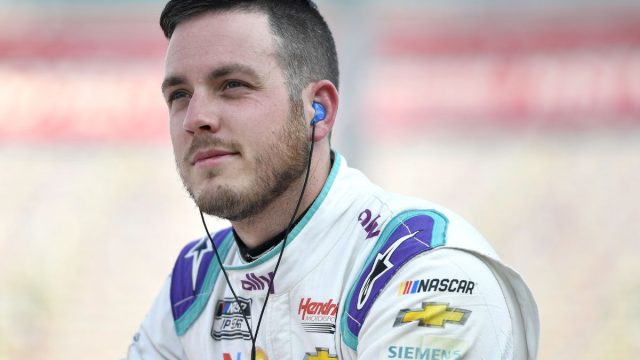Alex Bowman’s Fiery Radio Exchange: In NASCAR, the recent analysis by Corey LaJoie of Alex Bowman‘s fiery radio exchange not only captivates the audience but also offers a profound insight into the high-octane domain of motorsports where emotions run as high as the engines. LaJoie’s dissection of the incident reveals the intricacies of intra-team communications and the psychological endurance required in competitive racing.
Key Takeaways
- Corey LaJoie discussed the normalcy of tensions during races, reflecting on Bowman’s fiery exchange.
- LaJoie emphasized the importance of balancing ambition with team strategy in high-pressure situations.
- The breakdown highlights how intense stress can lead to communication challenges within NASCAR teams.
- LaJoie provided insight into the delicate team dynamics and the impact of individual emotions on overall performance.
- He suggested that clear communication is essential, despite the common occurrence of fiery exchanges under stress.
Drama at Dover
At Dover, tensions flared when Alex Bowman and his spotter Kevin Hamlin engaged in a heated exchange during the race, highlighting the stress-filled atmosphere of competitive racing. Such moments are not merely vital but reveal the broader dynamics at play in high-stakes motorsports. Communication between a driver and his spotter is essential, often functioning as the lifeline for strategic decisions made at breakneck speeds. When this communication breaks down, as witnessed between Bowman and Hamlin, it can lead to a cascade of on-track consequences, potentially derailing a strong finish.
The incident at Dover emphasizes the high pressure environment that drivers and their teams operate within. Every race weekend, they are tasked with making split-second decisions based on limited information and intense competition. This pressure is magnified by the expectant eyes of sponsors, fans, and personal ambition. Bowman’s fiery exchange with Hamlin may seem like a brief lapse in teamwork, but it is representative of the broader psychological and emotional endurance required in NASCAR racing.

LaJoie’s Analysis of the Situation
Corey LaJoie, a fellow NASCAR driver, provided a more detailed look into the Dover incident on his podcast, shedding light on the tensions that escalated between Alex Bowman and his teammate during the race. LaJoie pointed out that the core of the issue seemed to originate from a competitive clash, highlighting the demands and expectations that come with top-level racing. He noted that Bowman, driving the No. 48, was performing exceptionally well, maintaining a position in the top 5, which possibly heightened the stakes.
“There was a little bit of beef apparently between the #48 and the #5. The #48 was having a good run up there in top 5.”-LaJoie
LaJoie’s analysis explored the intricacies of team dynamics in NASCAR. He suggested that while teamwork is preached, the individual desire to win can sometimes cause friction among team members. This scenario was evident in the interaction between Bowman and his spotter, where communication turned sharp, reflecting a moment of intense competitive tension.
“Hey, it’s a very high-pressure situation. You feel like you’re in there riding around. You’d think your teammate of all people would air block you less, but hey, it’s racing man.” LaJoie said.
View this post on Instagram

Insight from Ryan Skip Flores
Providing an open perspective, Ryan Skip Flores went through Alex Bowman’s heated radio exchange, emphasizing the unfiltered honesty in Bowman’s reaction during the race. Flores, co-host of Stacking Pennies, delved deep into the intricacies of the tension-filled interaction that occurred on the racetrack, providing a clear window into the competitive nature of racing.
“He was mad at the #5 car air blocking him. The #5 was running for the stage win I believe. He’s mad at the #5 air blocking and he’s *expletive* about it and (Kevin) Hamlin says go up there and pass him, he’s not gonna give it to you. And then he tried to pep talk him and Alex told him shove it.” Flores said
- Tactical Air Blocking: The maneuver by the 5 car, which involved air blocking Bowman, was a strategic move often seen in racing but can lead to high tensions among drivers.
- Communication Dynamics: The interaction between Bowman and his spotter, Kevin Hamlin, highlighted a moment of intense communication under stress, where strategic advice was met with resistance.
“He’s not gonna pull over for you. You’ve gotta go *expletive* earn it, let’s go. #5 elbows up, let’s go. Dudes are gonna give you *expletive* all day, you’ve just taken, you’ve done awesome, drive like an *expletive* the rest of the race, stay locked in, *expletive* them all let’s go,” Kevin Hamlin
- Motivational Challenge: Hamlin’s attempt to motivate Bowman by urging him to overcome the challenge posed by the 5 car’s defense demonstrates the psychological aspects of racing where morale can pivot on every word spoken.
Bowman’s Response and Post-Race Comments
In the aftermath of the intense exchange, Alex Bowman’s request for silence from his spotter highlighted his desire to focus solely on steering through the challenges of the race. This moment of communication—or importantly, the request for its cessation—speaks volumes about Bowman’s mindset under stress.
“No. I don’t have any clickbait for you there, buddy.” -bowman
Post-race, Bowman’s reluctance to discuss the radio exchange further solidified his concentration on the sport rather than the surrounding drama. His dismissal of the opportunity to create ‘clickbait’ reveals his personality that prioritizes authenticity and straightforwardness over sensationalism. This approach can be seen as a shield against the often intrusive nature of media probing, aiming to maintain a certain sanctity of the competitive spirit and personal space.

High-Pressure Racing
High-pressure racing environments, such as the one experienced by Alex Bowman, often push drivers to their limits, revealing their capacity to manage intense stress and competition. In NASCAR racing, where split-second decisions can make or break a race, the psychological fortitude of drivers is as critical as their physical abilities. Bowman’s fiery exchange during the race is a reflection of the intense emotional environment that drivers navigate.
- Team Dynamics: Even within a team, competition can be fierce. Expectations to give way to a teammate can create conflicts, as seen in Bowman’s frustration with Larson’s air blocking.
- Communication: Effective communication between a driver and his spotter is crucial. Miscommunications can escalate to conflicts, especially under high tension.
- Emotional Control: Managing emotions during a race is important. Drivers must maintain composure to focus on strategy and performance despite internal and external pressures.
News in Brief: Alex Bowman’s Fiery Radio Exchange
The analysis of Alex Bowman’s fiery exchange by Corey LaJoie shines a light on the intricate dynamics within NASCAR teams, where competitive fervor often leads to tensions. Through LaJoie’s analysis and additional insights from industry professionals, a clearer understanding of the communication challenges and emotional strains in professional racing is achieved. This case study highlights the importance of effective communication and emotional management within high-pressure environments, emphasizing the broader implications for team strategies and individual performances in elite sports.
ALSO READ: Alex Bowman Honors Johnson and Knaus with Throwback Scheme
